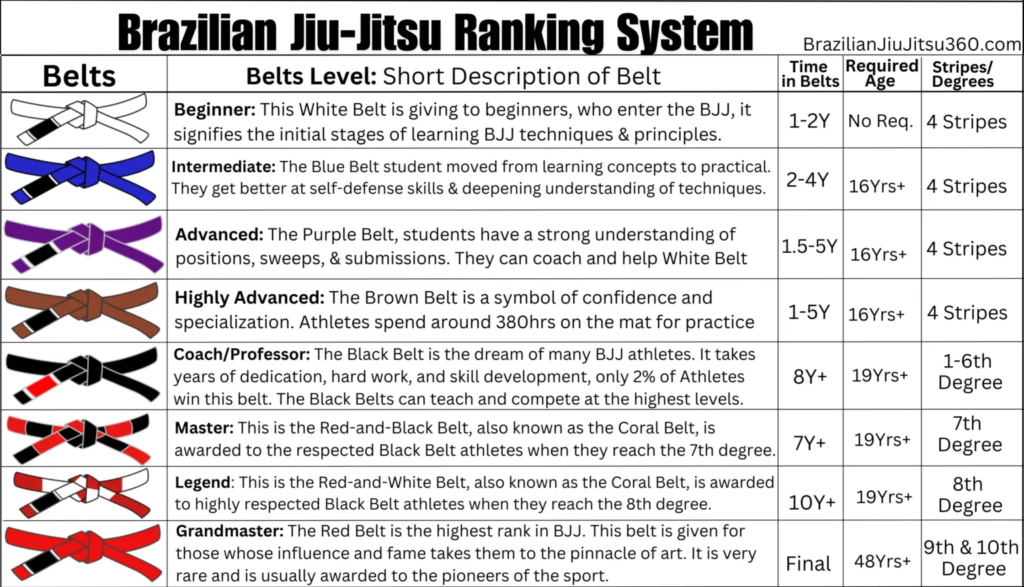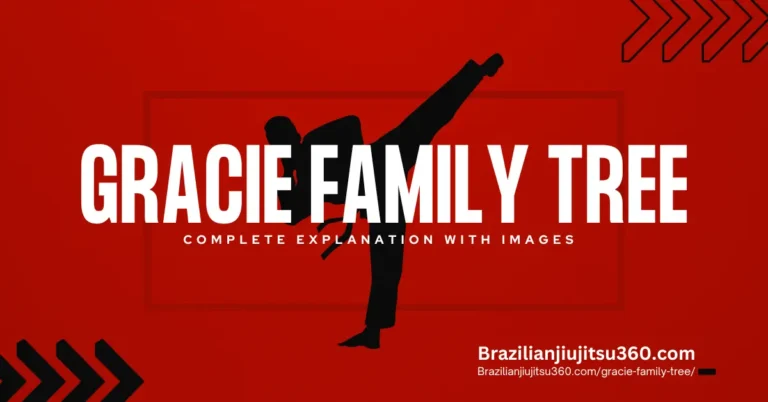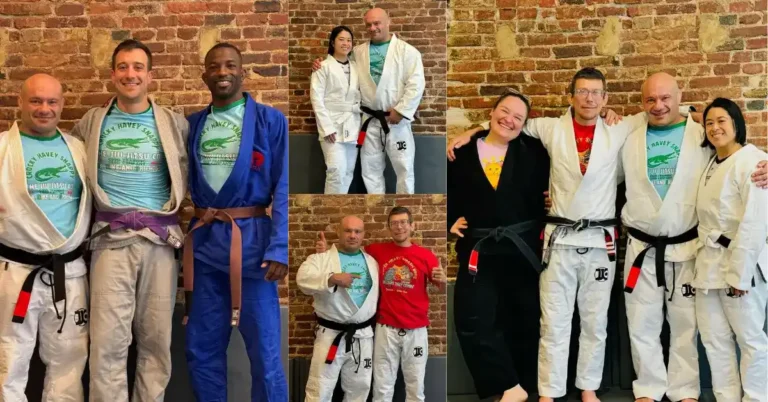BJJ Blue Belt Requirements (10 Steps)
When students enter in Brazilian Jiu-Jitsu (BJJ), they start with a white belt that has no stripes. A stripe is a small piece of tape or fabric added to the belt to signify progress within a specific belt rank. There are a total of four stripes that students must earn before advancing to the next belt. On the white belt, each stripe on average takes about 3 to 6 months to achieve.
Once students earn all four stripes on BJJ white belt, they are promoted to the second belt rank, which is the blue belt. To earn a blue belt, a practitioner must show a solid understanding and expertise in the basic techniques and movements of BJJ, such as escapes, submissions, and sweeps.
Let’s discuss all the requirements needed to achieve the BJJ blue belt.
1. At Least 16 Year Old (IBJJF Requirements)
The first BJJ blue belt requirement is that you must be at least 16 years old. This requirement, set by the International Brazilian Jiu-Jitsu Federation (IBJJF), ensures that the student has reached the minimum age to receive a blue belt in Brazilian Jiu-Jitsu. If they are younger than 16, they will instead progress through the kids’ belt system. Learn more here BJJ Kids Belts Explained.
2. Learning Time (Take on Average 125 Classes)
To progress to the blue belt in BJJ, consistent learning is important. On average, you must attend 25 classes to earn each stripe, totaling around 125 classes to complete all four stripes. However, this may vary depending on the academy, as some may require more or fewer classes. Achieving all four stripes commonly takes 1 to 2 years or longer.
3. Practicing Time (360 to 400 Hrs Practice on the Mat)
When you attend proper classes and learn the techniques, the next step is practice. You should aim to practice on the mat for an average of 360 to 400 hours. Make sure to dedicate this time and practice properly.
Now let’s discuss the techniques required to progress from a BJJ white belt to a blue belt.
4. Learn the Basics of Standing Skills and Strategies:
The BJJ game often starts in a standing position, and this is especially important for self-defense. In many real-life situations, fights begin while both people are standing, so it’s important to know how to control and defend yourself in this position before the fight goes to the ground. A strong stand-up game allows you to safely close the distance and either bring your opponent to the ground or avoid being taken down yourself. So move from white belt to the blue belt it is important to learn the all basics of standing skill includes:
- Takedowns and Takedown Defense: Learn basic takedowns like the single-leg and double-leg to bring your opponent to the ground. Practice sprawling to defend against takedowns and keep control of the fight.
- Grip Fighting: Control your opponent’s gi or body by fighting for grips. Strong grips help you set up takedowns and control movement, giving you an advantage in the stand-up game.
- Clinching: Close the distance to control your opponent’s body. Use the clinch to set up takedowns or create space for strikes, making it harder for them to control the fight.
5. Escape Yourself from Every Bad Position:
To moving to the BJJ blue belt, it is important to learning how to escape from bad positions. As a white belt, you’ll spend 1 to 2 years mastering these techniques, especially to get out of situations where your opponent has control. These skills are crucial for both BJJ and self-defense. By the time you become a blue belt, you should be confident in using these escapes. For example:
- If someone is on top of you in the mount position, you can escape by bridging your hips upward and turning to create space.
- If your opponent has you inside control, you can escape by using your arms and legs to push them away and reposition your body.
You can also watch the videos to learn more about the escapes:
6. Body Positioning:
BJJ is not just about strength, it’s about using techniques properly, against your opponent. One of the most important skills for a BJJ white belt to learn is proper body positioning. Understanding controlling positions is important for both offense and defense. Here are the some key positions to master include:
- Guard: Closed guard, open guard, and half guard.
- Top Control: Mount, side control, knee-on-belly, and north-south.
- Back Control: Using hooks with a seatbelt grip for effective control.
Learning and practicing these positions will help you build a strong foundation in BJJ and accelerate your progress toward earning your blue belt.
7. Sweeps (Unbalancing the Opponent and Throwing Them Down):
To move from a white belt to a blue belt in BJJ, you must know the basic sweeps, like the scissor sweep, hip bump, and flower sweep (as shown in the image below) to improve your position during a match. Sweeping refers to the techniques and strategies used to reverse or change positions when you are on the bottom and want to get on top of your opponent. A sweep is a move where you use your legs, hips, or other parts of your body to unbalance your opponent and turn them over, allowing you to take a dominant position.
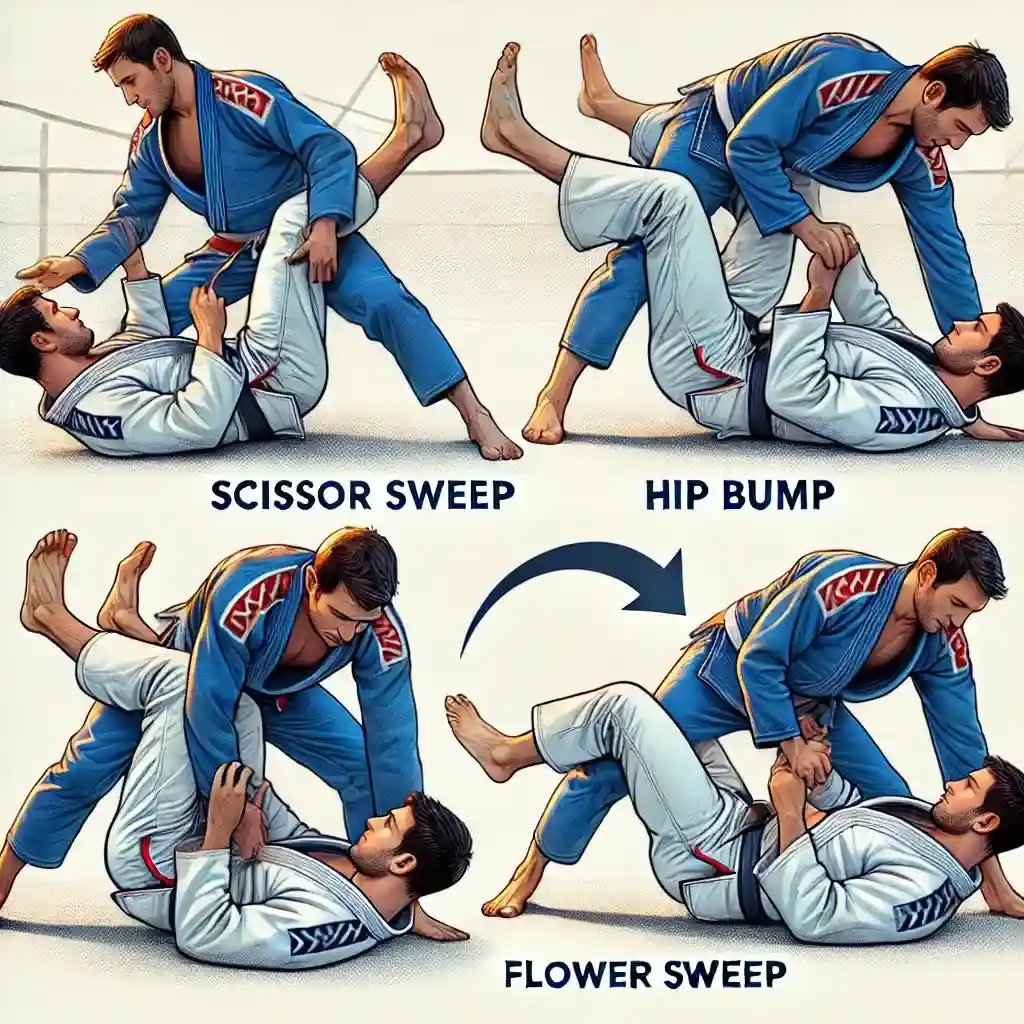
8. Learn at least 1 Submission Properly:
Submission is a technique and strategy used to force an opponent into a position where they have no choice but to tap out (submit). This usually involves joint locks, like arm bars or ankle locks, and chokeholds, such as the rear-naked choke or triangle choke, which apply pressure to joints or restrict airflow, forcing the opponent to give up.
You don’t need to learn all the submissions learn at least 1 submission and expert in them is an important BJJ Blue belt requirements, if you learn at least 1 submission properly it is enough to win a game or defend yourself in a street fight or any other place
Here are some of the most common submissions you need learn to learn at least 1 from them to move to the next rank:
- Armbar (from Guard and Mount):
The armbar is one of the most fundamental submissions in BJJ. It targets the opponent’s arm and hyperextends the elbow joint. - Triangle Choke (from Guard):
The triangle choke is a powerful submission where you use your legs to choke the opponent by trapping their neck with one of their arms inside your legs. This submission is often applied from the guard position. - Rear-Naked Choke (from Back Control):
This choke is applied from the back control position and is one of the most effective submissions. It involves wrapping the arm around the opponent’s neck and squeezing to restrict airflow. - Guillotine Choke (from Front Position):
The guillotine is a choke that targets the neck and can be performed when your opponent is trying to shoot for a takedown or in the front headlock position. It involves trapping the opponent’s head and applying pressure to their throat. - Kimura (from Guard or Top Position):
The kimura is a shoulder lock that can be executed from the guard or top position (side control or mount). It involves separating the opponent’s arm and applying pressure to the shoulder joint. - Americana (from Top Position):
Similar to the Kimura, the Americana is another shoulder lock, but it’s typically performed from the top position, such as side control or mount. It involves bending the opponent’s arm at a 90-degree angle and applying pressure on the shoulder. - Cross-Collar Choke (from Guard or Mount):
The cross-collar choke is a classic BJJ submission often performed from the guard or mount position. You use your opponent’s collar to choke them by pulling it across their neck with both hands. - Omoplata (from Guard):
The omoplata is a shoulder lock performed from the guard position using your legs. It’s a bit more advanced but is important to learn as it gives you another way to attack from the bottom.
9. Learn the Basics of Guard retention:
Another important requirement to move to blue belt is to learn the basics of guard retention. It means maintaining control of your guard position when your opponent tries to pass it. The guard is when you’re on the bottom, but your legs are used to control or defend against your opponent. Guard retention helps you prevent your opponent from getting past your legs and into a better position, such as side control or mount.
There are many types of guard retention, but you don’t need to be an expert in all of them to progress to blue belt. You just need to learn the basics, which are the BJJ blue belt requirements. Here are the main types:
- Closed Guard Retention: Keeping your legs locked around your opponent’s waist to maintain control and prevent them from breaking free.
- Open Guard Retention: Using your legs in a more flexible position (like spider guard or lasso guard) to control your opponent while keeping space between you and them.
- De La Riva Guard Retention: One of your feet hooks around your opponent’s leg while your other foot is placed on their hip or thigh, helping you maintain control and prevent passing.
- Half Guard Retention: When you’re on your side with one of your opponent’s legs trapped between your legs. This guard helps you defend and recover if they try to pass.
- Butterfly Guard Retention: Keeping one or both of your feet hooked inside your opponent’s thighs, allowing you to control their posture and prevent them from passing.
10. Learning the Basics of Passing Guard:
Learning the basics of passing guard is also important to move to the next rank, passing guard means getting past your opponent’s legs and moving into a better position to control them.
When someone is in the guard, they are on their back with their legs wrapped around you, using their legs to control your movement. To pass the guard, you need to find a way to break through their legs and get into a position like side control or mount, where you are on top and have more control. Here are the some basic types of guard passing in BJJ:
- Toreando Pass: You move around your opponent’s legs by grabbing them and pushing to the side, like a bullfighter.
- Knee Slice Pass: You slide your knee across their body to break through their guard and get to the side.
- Over-Under Pass: One arm goes under their legs, the other over. Then, you try to move around their guard.
- Double Under Pass: You put both arms under their legs, lift their hips, and then pass around their legs.
- Stack Pass: You push their knees toward their chest to make them off balance, then pass to the side.
Short overview of the article (Summary):
This article explains the steps and requirements for progressing from a BJJ white belt to BJJ blue belt. Initially, students start with a white belt and earn four stripes as they progress. After earning all four stripes, they can advance to the blue belt. To earn a blue belt, students must:
- You must be at least 16 years old to earn a blue belt according to IBJJF rules.
- On average, you need to attend 125 classes, or about 25 classes per stripe, to earn your blue belt.
- Aim to practice for 360 to 400 hours to gain the experience needed for a blue belt.
- Mastering standing skills like takedowns, grip fighting, and clinching.
- Learn how to escape yourself when you are in bad situation.
- Master controlling positions such as guard, mount, side control, and back control to improve your offense and defense.
- Learn basic sweeps, like the scissor sweep or flower sweep, to reverse positions and get on top of your opponent.
- Learn and master at least one submission, such as armbar, triangle choke, or rear-naked choke, to effectively finish a match.
- Master the basics of guard retention, which helps you maintain control of your guard and prevent your opponent from passing.
- Learn the basics of guard passing techniques, such as the Toreando pass, knee slice pass, and over-under pass, to move past your opponent’s guard.
You may like the our article about “12 Important Goals & 4 Techniques”
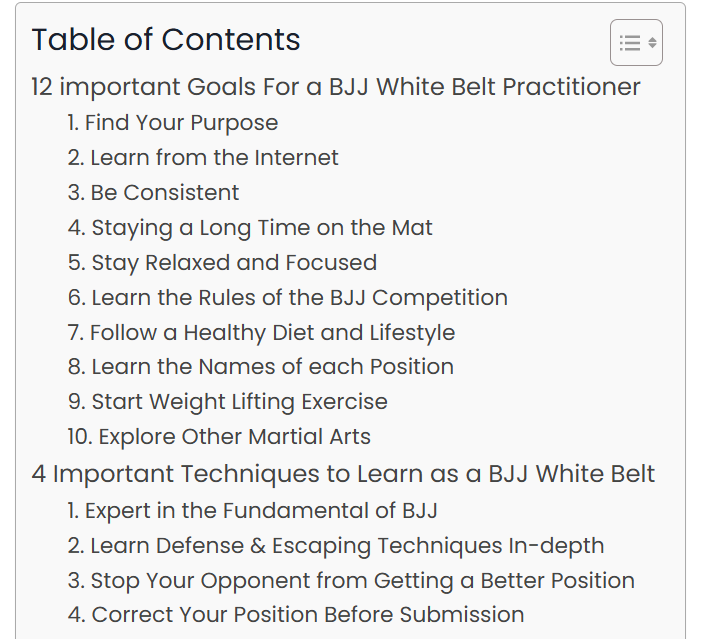
FAQs
Q: Is there any Test for BJJ Blue Belt?
Some BJJ schools have a test for the blue belt, where students show their skills by doing techniques like escapes, sweeps, submissions and more as discuued in the article. They may also be asked to spar and show how well they understand different positions.
In many schools, there is no formal test. Instead, the coach watches students during regular classes to see how much they’ve improved. They look at how well students use techniques, their effort, and how often they train to decide if they are ready for the blue belt.
Here is Some More Related Articles:
